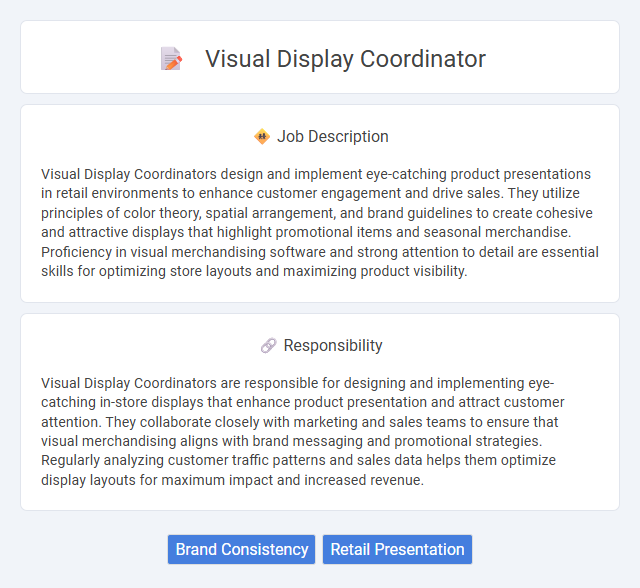
Visual Display Coordinators design and implement eye-catching product presentations in retail environments to enhance customer engagement and drive sales. They utilize principles of color theory, spatial arrangement, and brand guidelines to create cohesive and attractive displays that highlight promotional items and seasonal merchandise. Proficiency in visual merchandising software and strong attention to detail are essential skills for optimizing store layouts and maximizing product visibility.
Individuals with a keen eye for aesthetics and strong organizational skills will likely find the role of a Visual Display Coordinator suitable. Those who enjoy working in dynamic, fast-paced retail environments and can handle physical tasks such as setting up displays may have a higher probability of success. People who prefer routine work or limited social interaction might find this job less fitting for their strengths.
Qualification
A Visual Display Coordinator must possess strong design skills and proficiency in software such as Adobe Creative Suite to create compelling visual merchandising layouts. Experience in retail environments and an understanding of consumer psychology are essential for optimizing product presentation and store aesthetics. Effective communication and project management abilities ensure seamless collaboration with marketing teams and timely execution of display installations.
Responsibility
Visual Display Coordinators are responsible for designing and implementing eye-catching in-store displays that enhance product presentation and attract customer attention. They collaborate closely with marketing and sales teams to ensure that visual merchandising aligns with brand messaging and promotional strategies. Regularly analyzing customer traffic patterns and sales data helps them optimize display layouts for maximum impact and increased revenue.
Benefit
A Visual Display Coordinator likely enhances brand visibility and customer engagement, potentially increasing store traffic and sales. This role may also improve a company's aesthetic appeal, contributing to a stronger market presence. The position could offer creative fulfillment while developing valuable skills in design and merchandising.
Challenge
Visual Display Coordinator roles likely involve overcoming challenges related to balancing creativity with brand consistency. They probably face tight deadlines that require efficient time management and adaptability in fast-paced retail environments. Navigating varying customer preferences and spatial limitations may also present ongoing difficulties in delivering compelling visual presentations.
Career Advancement
Visual Display Coordinators develop expertise in merchandising, design, and retail trends, creating a strong foundation for career advancement. Mastery in spatial planning, branding strategies, and customer engagement often leads to opportunities as Visual Merchandisers, Store Managers, or Retail Marketing Specialists. Continuous skill development in digital design tools and leadership enhances prospects for senior roles within visual merchandising and retail management.
Key Terms
Brand Consistency
Visual Display Coordinators ensure brand consistency by expertly designing and implementing retail layouts that reflect the company's visual identity and marketing strategies. They collaborate closely with merchandising teams to maintain uniformity in color schemes, signage, and promotional materials across all store locations, enhancing customer recognition and loyalty. Proficient in interpreting brand guidelines, these professionals use innovative display techniques to create engaging environments that drive sales while preserving the brand's core message.
Retail Presentation
A Visual Display Coordinator specializes in creating compelling retail presentations that enhance product visibility and customer engagement. They strategically arrange merchandise, design window displays, and ensure brand consistency to drive sales and elevate the in-store shopping experience. Expertise in lighting, color theory, and spatial design is essential for optimizing visual impact and maximizing floor space effectiveness.
 kuljobs.com
kuljobs.com